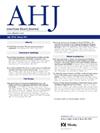冠心病合并2型糖尿病合并心衰风险患者筛查及干预策略的可能性
IF 3.5
2区 医学
Q1 CARDIAC & CARDIOVASCULAR SYSTEMS
引用次数: 0
摘要
NT-proBNP在不同临床情况下的实际应用应根据患者的情况进行解释。目的分析NT-proBNP在冠心病合并2型糖尿病患者LVEF保存和中度降低表型参数区间的变化。材料与方法130例冠心病(ESC)合并2型糖尿病患者(WHO, 1999),年龄63,9±8,8岁,冠心病合并2型糖尿病病程- 9,69±0,49和7,3±3,89年,HF中度降低(A组,n-60)和LVEF保留(B组(1),n-70)。根据H2FPEF量表将B组患者分为HF概率为50%(2)和50%(3)。分析了人口统计学、NP-proBNP、钠、eGFR、脂质和碳水化合物谱、LVEDP指标(E/A、E/ E′、LP指数、ILVMM)。基础治疗:抗血小板药物、-受体阻滞剂、RAAS受体阻滞剂、他汀类药物、依帕列净、i-DPP-4、二甲双胍。观察时间2年。结果A组与B组的NP-proBNP(结果)分别为1293、96±1658、80比396、21±477、97 pg /ml (t=36,979; p= 0000),观察组分别为1374、21±1967、36比362、86±624、96 (t=27,766; p= 0000)。B组与(2)和3个亚组比较,观察2年前后NP-proBNP无组间差异。基础治疗期间,EF <;50%组LVEF从45,2升高[43,2;47,8]至47.9% [45,2;54,3] (t=15,892; p=0,000),且在2和3中没有变化。观察2年前后LA (t=2,905; p=0,088)、LA体积(t=6,20; p=0,01)、EDD (t=4,72; p=0,03)、ESD (t=7,36; p=0,007) (t=6,72; p=0.01) (t=5,17; p=0,02)、E/ E′(t=9,917; p=0,002)和E/ E′(t=3,996; p=0,046)组间差异(2和3)。结论对于冠心病合并2型糖尿病患者,评价E/ E筛查对监测LVEF进展有重要意义;处方恩格列净时,LVEF指标改善。本文章由计算机程序翻译,如有差异,请以英文原文为准。
Possibilities of Screening and Intervention Strategies in Patients with Coronary Artery Disease and Type 2 Diabetes Mellitus with the Risk of HF
Introduction
The practical use of NT-proBNP in different clinical situations should be interpreted depending on the patient profile.
Objective
analysis of NT-proBNP in the intervals of parameters of phenotypes of preserved and moderately reduced LVEF in patients with coronary artery disease and type 2 diabetes mellitus.
Material and Methods
130 patients with coronary artery disease (ESC) and type 2 diabetes mellitus (WHO, 1999), age 63,9±8,8 years, duration of coronary artery disease and type 2 diabetes mellitus – 9,69±0,49 and 7,3±3,89 years, HF with moderately reduced (group A, n-60) and preserved LVEF (group B (1), n-70). According to the H2FPEF scale, patients in group B were divided into the probability of HF >50% (2) and <50% (3). Demographic, NP-proBNP, sodium, eGFR, lipid and carbohydrate profile, LVEDP indicators (E/A, E/e′, LP index, ILVMM) were analyzed. Basic therapy: antiplatelet agents, beta-blockers, RAAS blockers, statins, empagliflozin, i-DPP-4, metformin. Duration of observation is 2 years.
Results
The difference between groups A and B was shown in NP-proBNP (outcome): 1293,96±1658,80 vs. 396,21±477,97 pg /ml (t=36,979; p=0,000) and observation 1374,21±1967,36 vs. 362,86±624,96 (t=27,766; p=0,000), respectively. Comparison of group B with (2) and 3 subgroups did not register intergroup differences in NP-proBNP before and after 2 years of observation. During basic therapy, LVEF in the EF <50% group increased from 45,2 [43,2; 47,8] to 47,9% [45,2; 54,3] (t=15,892; p=0,000), and did not change in 2 and 3. Intergroup differences (2 and 3) were revealed in LA (t=2,905; p=0,088), LA volume (t=6,20; p=0,01), EDD (t=4,72; p=0,03) and ESD (t=7,36; p=0,007) before and (t=6,72; p=0.01) after (t=5,17; p=0,02), E/e` before (t=9,917; p=0,002) and after (t=3,996; p=0,046) 2 years of observation.
Conclusion
For patients with coronary artery disease and type 2 diabetes mellitus, it is important to evaluate E/e' screening to monitor the progression of LVEF; when empagliflozin is prescribed, LVEF indicators improve.
求助全文
通过发布文献求助,成功后即可免费获取论文全文。
去求助
来源期刊

American heart journal
医学-心血管系统
CiteScore
8.20
自引率
2.10%
发文量
214
审稿时长
38 days
期刊介绍:
The American Heart Journal will consider for publication suitable articles on topics pertaining to the broad discipline of cardiovascular disease. Our goal is to provide the reader primary investigation, scholarly review, and opinion concerning the practice of cardiovascular medicine. We especially encourage submission of 3 types of reports that are not frequently seen in cardiovascular journals: negative clinical studies, reports on study designs, and studies involving the organization of medical care. The Journal does not accept individual case reports or original articles involving bench laboratory or animal research.
 求助内容:
求助内容: 应助结果提醒方式:
应助结果提醒方式:


